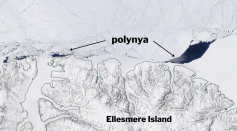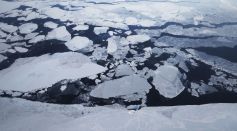Tags: Arctic sea ice
Loss of Arctic Sea Ice Due to Dipole Reversal: How Does North Atlantic Waters Affect Polar Climate

Giant Holes Formation in the Arctic Ice Sheet Shows Last Ice Area Is Less Resilient To Warming
Study Shows Worrying Acceleration of Global Ice Loss
Lingering Decline of the Arctic Sea Ice
Researchers Complete Year-Long Expedition in the Arctic Ocean

Climate Models Reveal Natural Causes of Little Ice Age

Arctic Sea Ice Recovery From the Effects of Climate Change is Impossible

Scientists Freeze Ship in the Arctic to Study Climate Change
Politician Says Melting Sea Ice is a Good Thing, Climate Change Experts Disagree
Arctic Climate Change Study Postponed Due To the Unexpected Motion Of The Arctic Sea Ice
12,000 Year-Old Methane-Leaking Craters Discovered In The Arctic Sea Floor
Polar Region Probe To Be Enhanced: UN
Arctic Winds Affected By Climate Change Causes Drastic Changes To Polar Bears, Marine Life & More
Sea Ice Record Breaking Decrease In South Pole & North Pole
Arctic Hits The Low Level Of Sea Ice: Scientists Find It Disturbing, Earth Is Overheating
Arctic Sea Ice Expansion, Blame It To Air Pollution Caused By Human
Most Popular

Black Hole Explained: The Science, Discovery, and Mysteries of the Universe's Darkest Objects

The Science of Sleep: Why It Matters and How Brain Cycles Restore Your Health

Navigating Genetic Engineering Ethics: Key Questions in the CRISPR Debate and Bioethics Boundaries

Neuroplasticity Explained: Unlocking Brain Rewiring for Better Mental Health Science




